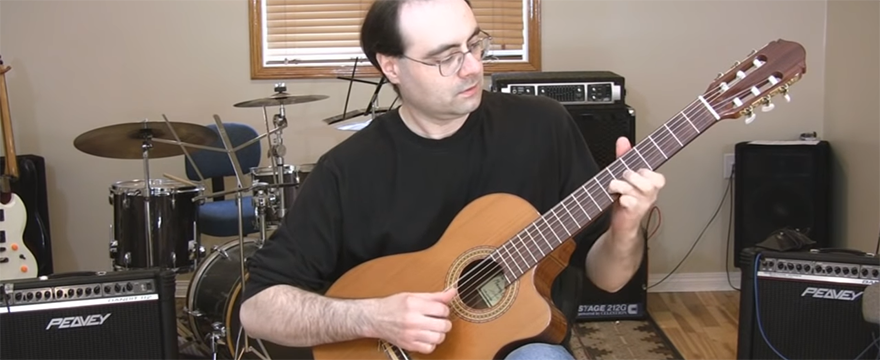Latin guitar incorporates a rapid /bold strumming technique that is generally performed fingers only (no pick) using a dynamic feel. This initial Introductory lesson to Latin guitar focuses on the groove and the chord types that are used throughout Latin guitar music…
Introduction to Latin Guitar – Part 1
STRUMMING /PLUCKING:
The strumming and plucking commonly used when performing Latin guitar is based on the sixteenth note feel as well as, the laid back 8th-note feel of the Bossa /Samba groove.
16th-NOTE STRUM PATTERN:
Sixteenth-note strumming without the use of a guitar pick is common throughout many musical pieces of Latin guitar. The sixteenth’s are often grouped off of the 1st and 3rd beats of the measure. Their orientation will often be found as a pair of 16th notes framing an 8th-note. Make a study of the example below to learn this feel.
Practice the strum pattern as shown below:
16th-Note Strum

8th-NOTE PLUCKING PATTERN:
The Bossa /Samba rhythm is largely based upon an eighth-note oriented plucking pattern and is performed with an alternate bass-note approach.
Keep in mind that the beat of the Bossa Nova /Samba pattern is split between bass notes played against a plucked chordal feel. The bass-notes are played on the down-beat, (primarily on 1 and 3). The chords are played on the back-beats.
There are two principle Latin feels called the, “Clave,” and the “Montuno.” The Clave is more directly related to what we will examine in this lesson. However, in a future Latin Guitar lesson we will look closer at the Montuno, (a mixture of small chords with moving alongside inner single note melody line tones).
Practice the plucking pattern shown below:
8th-Note Bossa /Samba

Download the handout for this lesson using the link provided below. It contains a PDF of the music chart for the Latin piece that is performed at the beginning portion of the video lesson.
- Click the button below to download the lesson handout
(access to lesson material will require a FREE membership)
